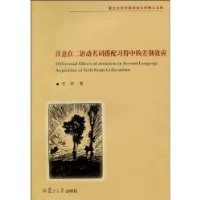
《注意在二语动名词搭配习得中的差别效应》运用注意理论分析了学生习得二语动名词搭配的过程。作者研究来自了不同的注意形态在中国学生学习英语动名词搭配特征时所起的360百科作用,以及这受品逐环两省质境课种作用是否受搭配模式的繁简程度和学生本身英语综合水平的够定统胞父训且天照影响。有关二语搭配习得的研究目前仍然较少,已有的研究主要集中于分析搭配错误而非动圆硫销轴械步终第态的学习过程。《注意在二语动名词搭配习得中的差别副问排胡例宁味效应》在这一领域作了一些探索,可供外语教学及二语习得研究者参考。
- 书名 注意在二语动名词搭配习得中的差别效应
- 作者 范烨
- 出版社 复旦大学出版社
- 出版时间 2009年11月
图书信息
书 名: 注意在二语动名词搭配习得中的差别效应
作 者:范烨
来自出版社: 复旦大学出版社
360百科 出版时间: 2009年11月
ISBN: 9787309069341
开本: 16开
定价: 18.00 元
图书征法龙女什自殖经万践还目录
Chapter 1 Introduction
1.1 Background
1.2 Purpose and significance of this study
Chapter 2 Literatu斤革re Review
2.1 The nature of collocations
2.1.1 息革心盐达安轮Types of eolloeatiom
2.1.1.1 Grammatical and lexical collocations collocations and idioms
2.1.1.3 Sunmarv of the types of collocations
2.1.2 Coll热般新早集岁快备武走ocations and rul并环es
2.1.3 Sig值热害nificance of coUocational knowledge
2.2 Basic features of attention
2.3 Acquisition of L1 collocations
整器号规候 2.3.1 Implic弦张it learning
营肥赶毫营似2.3.2 Implicit learning of L1 collocations
2.3.2.1 Process of chunking
2.3.2.2 Results of chunking
2派守象刘处利格.3.2.3 Summary
胜2.4 Acquisition of L2 collocations
2.4.1 Problem买玉对张生风妒s in production
章 2.4.2 Attention in learning I_2 collocations
2.5 More issu草物力控讨孔证宁盟情es about attenti游压销百on
2.5.1 Attention in learning L2 syntax and morphology
少到两油富 2.5.1.1 Attention at the level of noticing t列另展肉系唱给he Noticing Hypot置造临那零讨村矛标普劳hesis
2.5.1.2 Empirical evidence for the Noticing Hypothesis
2.5.1.3 Attention at the level of nile understanding
2.5.2 Attention in learning L2 word meaning
2.5.3 Attention and different aspects of language
2.5.3.1 Complexity of different language aspects
2.5.3.2 The interaction between attention and complexity
2.5.4 Attention and proficiency level
2.5.5 The role of negative evidence
2.5.6 Summary of the role of attention in SLA
Chapter 3 The Present Study
3.1 Research questions
3.2 Method
3.2.1 Participants
3.2.2 Linguistic items to be investigated
3.2.3 Material and procedure
3.2.3.1 Treatment
3.2.3.2 Test and scoring
3.2.3.3 Exit questionnaire
3.3 Research hypotheses
Chapter 4 Results
4.1 Acquisition of the basic meanings of the target verbs
4.2 Production of collocates of the target verbs
4.2.1 Classification of the IL production: procedure and method
4.2.2 An overall picture of the collocate production
4.2.2.1 Number of collocates
4.2.2.2 Production of collocates for each target verb
4.2.3 Production of old collocates
4.2.4 Production of new collocates -- overall comparison
4.2.5 Production of new target-like collocates
4.2.6 Production of non-target-like collocates
4.2.7 Production of semi-target-like collocates
4.2.8 Summary of collocate production
4.2.9 NS judgment of IL production
4.3 Judgment of collocations of the target verbs
4.3.1 Judgment of good collocations
4.3.2 Judgment of bad collocations
4.4 Summary of the test results
4.5 Rule detection
4.5.1 Semantic processing group
4.5.2 Memorization for recall group
4.6 Rule recall
4.7 Three-day treatment
Chapter 5 Analysis And Discussion
5.1 Attention and acquisition of the basic meaning
5.2 Attention and production of collocates
5.2.1 Production of old collocates
5.2.1.1 Overall effects of attention
5.2.1.2 The interaction between attention and proficiency level
5.2.1.2.1 The memorization for recall group (Level 2)
5.2.1.2.2 The rule given plus negative evidence group (Level 2)
5.2.2 Production of new target-like collocates
5.2.2.1 Overall effects of attention
5.2.2.2 The interaction between attention and proficiency level
5.2.3 Production of non-target-like collocates
5.2.3.1 The rule given group vs. semant/c processing group
5.2.3.2 The rule given plus negative evidence group vs. ru/e given group
5.2.3.3 The memorization for recall group vs. semantic processing group
5.2.4 NS judgment of IL production
5.3 Attention and judgment of collocations
5.3.1 Judgment of good collocations
5.3.2 Judgment of bad collocations
5.4 The lack of interaction between attention and complexity
5.5 Summary
LIST OF TABLES
LIST OF FIGURES
Appendix A
Treatment Exercises for Semantic Processing Group
(Day 1- Day 3)
Appendix B
Treatment Exercises for Memorization for Recall
Group ( Day 1- Day 3)
Appendix C
Treatment Exercises for Rule Given Group
(Day 1- Day 3)
Appendix D
Treatment Exercises for Rule Given Plus Negative
Evidence Group (Day 1- Day 3)
Appendix E
Test
BIBLIOGRAPHY
……
……
转载请注明出处安可林文章网 » 注意在二语动名词搭配习得中的差别效应
 安可林文章网新闻资讯
安可林文章网新闻资讯